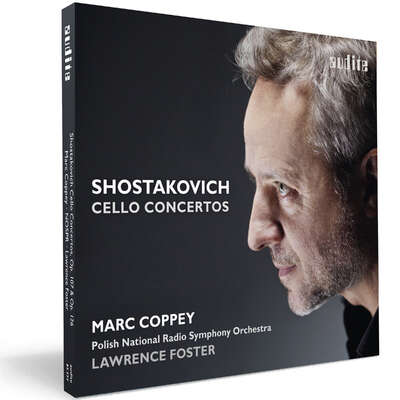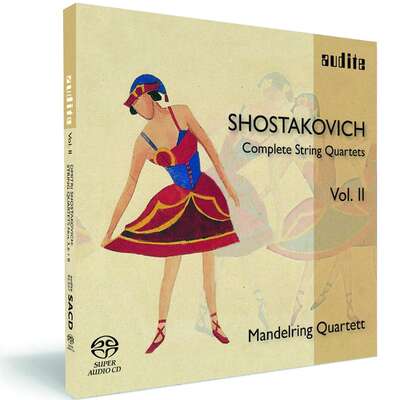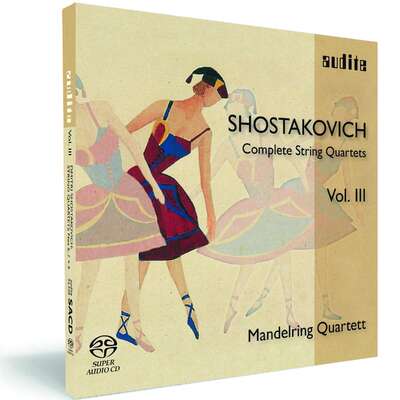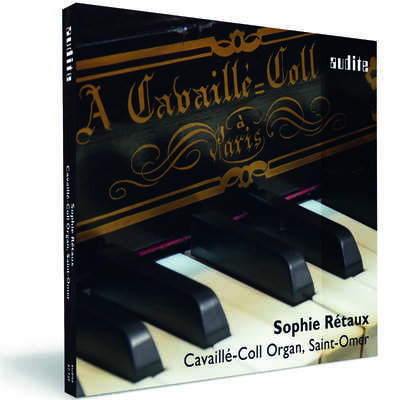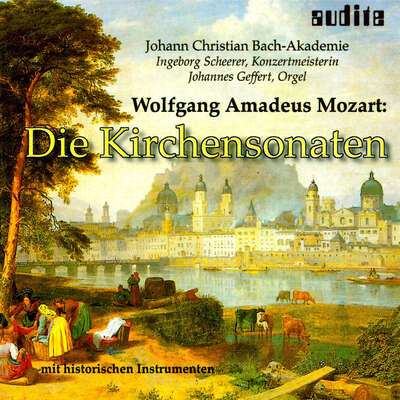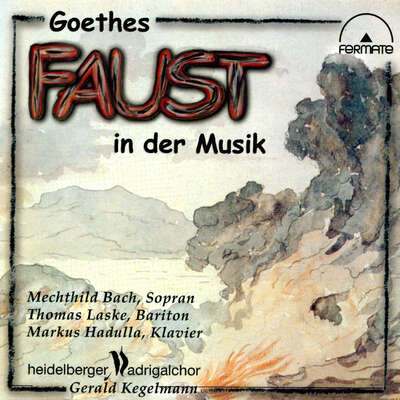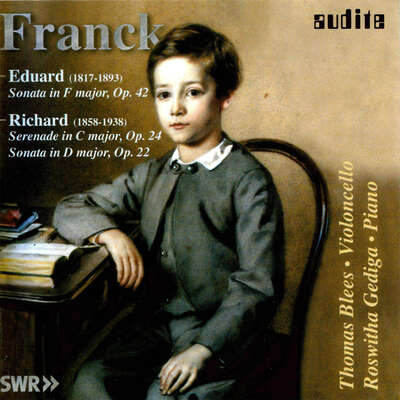
Judith Ingolfsson and Vladimir Stoupel embark upon a challenging programme: two masterworks of twentieth century chamber music by Igor Stravinsky and Dmitri Shostakovich whose characteristics could not be more disparate.more
Judith Ingolfsson and Vladimir Stoupel embark upon a challenging programme: two masterworks of twentieth century chamber music by Igor Stravinsky and Dmitri Shostakovich whose characteristics could not be more disparate.
Details
|
Igor Stravinsky & Dmitri Shostakovich: Works for Violin and Piano
Stravinsky: Divertimento & Shostakovich: Sonata for violin and piano, Op. 134 |
|
| article number: | 92.576 |
|---|---|
| EAN barcode: | 4022143925763 |
| price group: | ACX |
| release date: | 9. December 2011 |
| total time: | 54 min. |
Bonus Material
- Review BBC Radio3_20120211
-
Interview Judith Ingolfsson_112014
"The Times of War"
Informationen
The Divertimento for violin and piano by Igor Stravinsky, written in 1932 as an arrangement of his ballet Le Baiser de la Fée, and the sonata for violin and piano by Dmitri Shostakovich, composed in 1968 on the occasion of David Oistrakh’s 60th birthday, could hardly be more disparate: Stravinsky’s work is a spirited homage to Tchaikovsky, based on songs and piano pieces by that composer, whereas the Shostakovich is a profound and mysterious contribution to the genre of the violin sonata. Both works, however, share a preference for an allegorical and deeply mysterious idiom and symbolism which, in Stravinsky’s case, results in brilliant, but also cool, “music on music”, whereas Shostakovich’s piece appears as a form of internal biography. For interpreters performing both pieces for one disc or in the same concert, one of the main challenges and attractions of this combination lies in tracing the cultural, musical and political experiences and values shared by both composers. In this performance, Judith Ingolfsson and Vladimir Stoupel have accomplished that task with mastery.
Reviews
Heilbronner Stimme | Donnerstag, 13.September 2012 | Uwe Grosser | September 13, 2012 Natürlichkeit
Das Ergebnis ist faszinierend, weil hier eine Natürlichkeit im Spiel vorherrscht, die die Komposition und nicht das Virtuosentum in den Mittelpunkt stellt. Hinzu kommt der exzellente Klang der CD, die Audite gemeinsam mit Deutschlandradio Kultur produziert hat. Mehr lesen
www.arkivmusic.com | 01.07.2012 | Robert Maxham | July 1, 2012
Violinist Judith Ingolffson finds great warmth in the lower registers ofMehr lesen
Neue Zürcher Zeitung | Nr. 143 (22.06.2012) | tsr | June 22, 2012 Tänzerisch und spröde
Kammermusik für Violine und Klavier hat bei Igor Strawinsky und DmitriMehr lesen
F. F. dabei | Nr. 10/2012 (05.-18.05.2012) | May 5, 2012 Strawinsky/Schostakowitsch: Divertimento & Violinsonate
Sie könnten kaum entgegengesetzter sein: das Divertimento für Violine undMehr lesen
American Record Guide | 01.05.2012 | Joseph Magil | May 1, 2012
Now that Shostakovich’s Violin Sonata has entered the mainstream repertoire, a common interpretation of it has emerged. The timings of each movementMehr lesen
The Soviet-born Yevgeny Kutik is more sensitive to the oppressive mood of the Shostakovich sonata and makes many more well-considered nuances than Ingolfsson does. Listen to Ingolfsson’s expressionless playing in the second subject of I and compare it with Kutik’s more bumpy, angular phrasing. Still, the greatest Shostakovich Violin Sonata that I’ve ever heard remains the amazing performance by the young brother-sister duo of Sergei and Lusine Khachatryan (July/Aug 2008).
Ingolfsson’s playing in Stravinsky’s Divertimento is not much better. Just compare the opening bars of the Sinfonia with the magic spell chanted by Cho-Liang Lin and Andre- Michel Schub in their classic recording. This isn’t a bad interpretation, but it is pedestrian.
Alfred Schnittke’s Violin Sonata 1, written in 1963, is obviously cut from the same cloth as the Shostakovich. While Schnittke’s signature polystylism is especially evident in the hymnlike tune at the end of the Largo and the pop tune-like dance at the start of the finale, a dark mood prevails, with much acerbic humor, if this can even be called humor.
It is interesting that Kutik would program the two works by Joseph Achron in a program titled Sounds of Defiance—the famous Hebrew Melody of 1911 and the Hebrew Lullaby of 1913. Achron was born in Russia in 1886. He certainly must have been aware of the horrible pogroms. He left the Soviet Union in 1922, never to return. Arvo Part’s Mirror in the Mirror, written in 1978, is a minimalist work with a vaguely religious atmosphere.
This is the first time I have heard Kutik, and I hope it will not be the last. He is always thinking, always playing the music, not just the notes.
Das Orchester | 04/2012 | Werner Bodendorff | April 1, 2012
Zwei große russische Komponisten der „klassischen Moderne“, dieMehr lesen
Record Geijutsu | April 2012 | April 1, 2012
japanische Rezension siehe PDFMehr lesen
Platte 11
| 29.03.2012 | Heinz Gelking | March 29, 2012
Strawinski / Divertimento und Schostakowitsch / Violinsonate
Two contrasting 20th-century-pieces for violin and piano, excellently played and recorded.
Das Divertimento von Igor Strawinski und die Violinsonate von DmitriMehr lesen
Crescendo Magazine | 01.03.2012 | Bernard Postiau | March 1, 2012
Nous voici une fois encore devant un de ces innombrables disquesMehr lesen
The Strad | March 2012 | Catherine Nelson | March 1, 2012 Powerful recordings of two highly different Russian violin works
Stravinsky's Divertimento is an arrangement of the music from his balletMehr lesen
Diverdi Magazin | marzo 2012 | Ignacio González Pintos | March 1, 2012
La extraña pareja
Obras para violín y piano de Stravinski y Shostakovich
Algo más que una diferencia generacional separa a Stravinsky de Shostakovich. El significado, tan dispar, de la obra de cada uno de ellos simbolizaMehr lesen
Gramophone | March 2012 | John Warrack | March 1, 2012 Stuttgart professor explores parallels from two Russians
Though the booklet-note writer declares that between Stravinsky and Shostakovich there is a “disparity in the conception of musical art which couldMehr lesen
It is obvious in the use of some of Tchaikovsky's songs and piano pieces for Stravinsky's Divertimento based on his ballet The Fairy's Kiss, and it is again strongly present in the klezmer-like Allegretto of Shostakovich's powerful Sonata; all seized upon with great brio here, as they need to be. There is also the invocation of earlier composers, with Stravinsky's exuberant Tchaikovsky transformations and with Shostakovich's profound homages to Bach.
Ingolfsson and Stoupel draw the Bach inspiration out in the deceptively straightforward opening Andante and in the long Largo finale to Shostakovich's Sonata, a marvelous, haunting piece of extended musical thought which is handled with superb control. There is also a less readily identifiable but very Russian sense of energy in the more vigorous dance music, which can seem to be on the verge of breaking out of control, especially in the Shostakovich's central movement. Both composers also respond to the inspiration of bell sounds, something again very Russian and vividly invoked here.
These are both strong, perceptive performances, recorded closely and lucidly, in which the complicated ambiguities in the music of both composers take hold powerfully below the sometimes jaunty surface.
Audiophile Audition | February 28, 2012 | Steven E. Ritter | February 28, 2012
Stravinsky: Divertimento; Shostakovich: Violin Sonata – Vladimir Stoupel, p./ Judith Ingolfsson, v. – Audite
Two wildly divergent faces of Russian composition
The Ice Maiden by Hans Christian Andersen served as the storyline fodderMehr lesen
BBC Radio 3 | 11. February 2012 | Helen Wallace and Andrew McGregor | February 11, 2012 BROADCAST CD review
Our next recital, Shostakovich and Stravinsky with Judith Ingolfsson and Vladimir Stoupel, is an unusual combination. It is a brave thing to put theMehr lesen
[Stravinsky Divertimento, Sinfonia excerpt]
They found the right combination – it is light and witty, but there is still that darkness and weight to it as well. There is a very strong sense of powerful personalities coming through. They play the very witty and sparkly “pas de deux” with aplomb, but there is a real edge to their playing. That edge comes out in the Shostakovich – I really feel that they have these reserves to draw on which you need with Shostakovich. The dark undertones in this piece are not hidden at all. It is brooding, and it has got anguish. It is a great big structure as well. They go down into the depths of this piece and they get that great spiral structure very beautifully worked out in the last movement. We are going to hear from that slow final movement an excerpt where the violin starts with that very veiled vulnerable sound and then moves up a gear into something very intense.
[Shostakovich Sonata, excerpt from the 3rd movement]
This really is a “take no prisoners” approach – the way they build to that climax. They have a very real, dark, Russian feel to this piece and there is a compelling sense of an unfolding narrative. I was very convinced by this – the unity of the structure they really achieved – that, they realized that beautifully. It is incredibly impressive and it is a great combination with the Stravinsky.
Ensemble - Magazin für Kammermusik | 1-2012 Februar / März | Carsten Dürer | February 1, 2012 Große Phrasierungsideen
Zwei der großen russischen Kammermusikwerke des 20. Jahrhunderts habenMehr lesen
Fono Forum | Februar 2012 | Clemens Haustein | February 1, 2012 Komponierte Leere
Unterschiedlicher könnten zwei Stücke einer CD nicht sein. Hier Strawinskys lustig-nostalgisches Divertimento; da Schostakowitschs Violinsonate op.Mehr lesen
Schostakowitschs Sonate von 1968 wirkt nach Strawinskys Tschaikowsky-Adaption – für das Divertimento griff Strawinsky auf sein Ballett "Kuss der Fee" zurück, in dem er Musik Tschaikowskys verwendete – wie ein Schock. Schostakowitschs Musik ist so ausgedünnt, bewegt sich in so trostloser Zweistimmigkeit fort, dass man schon von komponierter Leere sprechen kann.
Eine Leere, die den Interpreten seltsamerweise ein Höchstmaß an Kraft und Konzentration abverlangt: Wo die kompositorischen Mittel so reduziert sind, wird das Musizieren zur Meditation. In diesem Sinn schaffen Judith Ingolfsson (Violine) und Vladimir Stoupel (Klavier) eine Einspielung, die Melancholie spüren lässt und dennoch den letzten Zugang zur musikalischen Leere Schostakowitschs schuldig bleibt. Vielleicht liegt das Problem im relativ langsamen Tempo von Eingangs- und Schlusssatz, das Ingolfsson und Stoupel nicht mit Intensität füllen können. Svjatoslav Richter und Igor Oistrach gehen da im Mitschnitt der Uraufführung wesentlich unkomplizierter zu Werke. Vielleicht hätte im Gegenzug Strawinskys Divertimento weniger Intensität gutgetan: Ingolfsson spielt vor allem den Tschaikowsky-Aspekt des Werkes aus und vergisst dabei den kühlen Ton des Neoklassizismus.
RBB Kulturradio | Mo 02.01.2012 | Ulrike Klobes | January 2, 2012 Strawinsky: Divertimento und Schostakowitsch: Violinsonate
Zwei große kammermusikalische Werke der russischen Moderne haben die Geigerin Judith Ingolfsson und der Pianist Vladimir Stoupel neu eingespielt: DasMehr lesen
Judith Ingolfsson – ein Name, den man sich merken sollte
Bereits mit 14 studierte die gebürtige Isländerin am Curtis Institute of Music in Philadelphia bei Jascha Brodsky, der schon so manchem Geiger zu Weltruhm verholfen hat. Mittlerweile unterrichtet Ingolfssen, neben ihrer Konzerttätigkeit, selbst als Geigenprofessorin in Stuttgart. Mit Vladimir Stoupel, einem russischstämmigen Pianisten, hat sie schon sehr oft zusammengespielt. Was die beiden verbindet, ist ihre Vorliebe für die Musik des 20 Jahrhunderts.
Zwei gegensätzliche Meisterstücke der russischen Moderne
Strawinskys Divertimento kann getrost als heitere Hommage an Peter Tschaikowsky verstanden werden. Zunächst stellte Strawinsky Salonlieder und Klavierstücke von Tschaikowsky zu dem Ballett „Der Kuss der Fee“ zusammen. Der Geiger Samuel Dushkin, der auch schon Strawinskys Violinkonzert in Amerika uraufgeführt hatte, brachte ihn 1932/33 auf die Idee, eine Besetzung für Violine und Klavier zu schreiben. Und so entsprechen die vier Sätze des Divertimentos genau den Szenen des Balletts: eine raffinierte und witzige Verwebung von Tschaikowsky-Themen, ganz im neoklassizistischen Strawinsky-Stil.
Schostakowitschs Violinsonate ist um einiges jünger, 1968 für David Oistrach geschrieben, kommt sie sehr viel spannungsgeladener, gedämpfter und fast ein wenig karg daher.
Virtuos und entschlossen
Gewissenhaft und trotzdem mit großer Leichtigkeit präsentieren Judith Ingolfsson und Vladimir Stoupel die beiden Werke. Ihr Strawinsky überzeugt vor allem durch die virtuose Herausarbeitung der lyrischen Melodien. Die Schostakowitsch-Sonate spielen sie ein wenig langsamer als gewohnt, was dem Stück aber durchaus gut tut. Judith Ingolfsson legt sich wirklich hinein in die lang gehaltenen Töne, so dass ein warmer, entschlossener und manchmal auch angriffslustiger Klang entsteht. Gleichzeitig kann sie sich an den leiseren Stellen wunderbar zurücknehmen, bis hin zum sachten, einfühlsamen Pianissimo.
Auch Vladimir Stoupel erweist sich als Kenner seiner beiden Landsmänner, solide liefert er die Grundlage für die Ausflüge der Violine: Ein glasklares Zusammenspiel mit einem sicheren Gespür für die feinen Verästelungen und großen Gegensätze, die beide Werke gemeinsam haben.
Audio | 1/2012 | AF | January 1, 2012
Zunächst ist man einfach nur hingerissen von dem glasklaren, detailreich aufgenommenen Klang der Violine – und dann davon, wie die Brodsky-Mehr lesen
Pizzicato | N° 219 - 1/2012 | Guy Engels | January 1, 2012 Zum Bersten spannend
Mit seinem Divertimento griff Igor Strawinsky die klassische Tradition eines Haydn oder Mozart auf. Er machte das mit der ihm eigenen, starkMehr lesen
Dmitri Shostakovich hat die Violinsonate op. 134 in seinen letzten Lebensjahren geschrieben, Jahre, die vom körperlichen Verfall des Komponisten gezeichnet sind. Selbst wenn man das Werk nicht zu sehr biographisch deuten sollte, ist der Abgesang an das Leben nicht zu überhören. Mit bestechender Rhetorik arbeiten Judith Ingolfsson und Vladimir Stoupel die recht morbide Stimmung des Werkes heraus. Sie gestalten die Sonate scharf und pointiert im Allegretto, mit schicksalhafter Wucht und einem regelrechten Gewitter an Emotionen im abschließenden Largo.
BBC Music Magazine | January 2012 | MC | January 1, 2012
Ingolfsson inhabits the balletic world of Stravinsky with as much commitment as the hermetic space of Shostakovich. There are some strange recordingMehr lesen
Hessischer Rundfunk | hr2-Kultur: Der CD-Tipp, Mittwoch, 28.12.2011, 13.05-13.30 Uhr | Niels Kaiser | December 28, 2011 CD-Tipp
Es begrüßt Sie ganz herzlich Niels Kaiser. Unsere heutige CD stellt anMehr lesen
Gesellschaft Freunde der Künste
| 19.12.2011 | December 19, 2011
Widmen sich zwei Meisterwerken der Kammermusik
Konzert/Musik Klassik: Strawinsky Divertimento & Schostakowitsch Violinsonate mit Judith Ingolfsson (Violine) und Vladimir Stoupel am Klavier
Das Divertimento für Violine und Klavier von Igor Strawinsky, entstanden 1932 als Bearbeitung seines Balletts Der Kuss der Fee, und die Sonate fürMehr lesen
Bei Strawinskys Werk handelt es sich um eine geistvolle Hommage von Salonliedern und Klavierstücken Tschaikowskys, bei Schostakowitsch dagegen um einen tiefsinnigen und rätselhaften Beitrag zur Gattung der Violinsonate. Beiden Werken ist jedoch die Vorliebe für eine allegorische bzw. tief verrätselte Klangsprache und -symbolik gemeinsam, die im Falle Strawinskys zu einer glanzvollen, aber auch kühlen „Musik über Musik“ führt, bei Schostakowitsch dagegen zu einer Art innerer Biografie. Die Herausforderung und der Reiz für Interpreten, diese beiden Stücke auf einer SACD oder im selben Konzert miteinander zu konfrontieren, besteht nicht zuletzt darin, gemeinsamen kulturellen, musikalischen und politischen Erfahrungen und Werten beider Komponisten nachzuspüren, wie es Judith Ingolfsson und Vladimir Stoupel in der vorliegenden Einspielung meisterhaft gelungen ist.
klassik.com | 19.12.2011 | Sophia Gustorff | December 19, 2011 | source: http://magazin.k... Selbstbewusst und souverän
So sehen Sieger aus. Zumindest stellt man sie sich so vor: Der Pianist mitMehr lesen
www.ResMusica.com | 28 novembre 2011 | Nicolas Derny | November 28, 2011 Leçon de musique russe par Judith Ingolfsson et Vladimir Stoupel
Il est des cas où l’ «arrangement» (et tout ce qui y est assimilé deMehr lesen
Fanfare | 18.06.2012 | Robert Maxham
Violinist Judith Ingolffson finds great warmth in the lower registers of her 1750 Lorenzo Guadagnini violin for the Sinfonia of Igor Stravinsky’sMehr lesen
The contrast of an almost metallic brightness with shadows, and shadowy dimness streaked only occasionally by light, that the two works offer, of course, allows Ingolfsson to draw upon the correspondingly contrasting sides of her musical personality, her tone production, and the capabilities of her instrument; all three respond to the challenges of Dmitri Shostakovich’s late work. It seems to be a tough sell; even dedicatee David Oistrakh, who recorded the sonata with Sviatoslav Richter (Mobile Fidelity MFCD 909, presumably no longer available), and who set a very high standard, hardly popularized the piece. Ingolffson and Stoupel play with reserved puckishness in the first movement (so did Leila Josefowicz, whose performance with John Novacek on Warner, 2564 62997-2 I very strongly recommended in Fanfare , 30:2, preferring it to the reading by Oistrakh’s own student Lydia Mordkovich on Chandos 8988), and they hack and slash their way aggressively through the second movement’s thickets of irony. Ingolffson sounds particularly commanding as she dispatches the movement’s difficulties, and the engineers have captured the dynamic range of the instruments in the most tumultuous sections. By contrast, they set the pizzicato statement of the final movement’s passacaglia theme and the first variations in a very subdued light, which remains through the movement.
In Fanfare 26:5, I noted that Ilya Grubert’s performance on Channel Classics 16398 lacked, in its last movement, Oistrakh’s “depth of reflection.” I also thought that his reading of the second movement hardly matched “both the last measure of Oistrakh’s fervor and the caustic bite of his pessimism.” Could that be said of Ingolfsson’s reading of the finale as well? However Ingolfsson stands in relation to Oistrakh, however, she demonstrates probing insight into the sonata—as she does into Stravinsky’s pastiche, and her pairing of them deserves a strong recommendation.
News
Violinist Judith Ingolffson finds great warmth in the lower registers of her...
Now that Shostakovich’s Violin Sonata has entered the mainstream repertoire, a...
Violinist Judith Ingolffson finds great warmth in the lower registers of her...
Zwei große russische Komponisten der „klassischen Moderne“, die jeweils in...
Strawinski / Divertimento und Schostakowitsch / Violinsonate
Powerful recordings of two highly different Russian violin works
Ingolfsson inhabits the balletic world of Stravinsky with as much commitment as...
Nous voici une fois encore devant un de ces innombrables disques irréprochables...
Stravinsky: Divertimento; Shostakovich: Violin Sonata – Vladimir Stoupel, p./ Judith Ingolfsson, v. – Audite
Strawinsky: Divertimento und Schostakowitsch: Violinsonate
Widmen sich zwei Meisterwerken der Kammermusik
Zunächst ist man einfach nur hingerissen von dem glasklaren, detailreich...
Leçon de musique russe par Judith Ingolfsson et Vladimir Stoupel



































